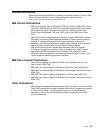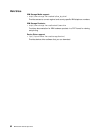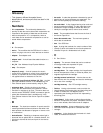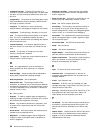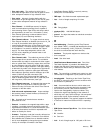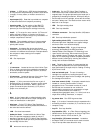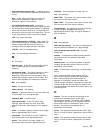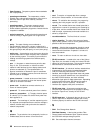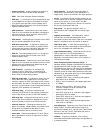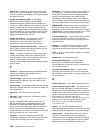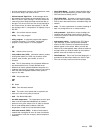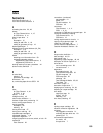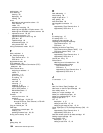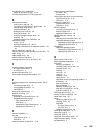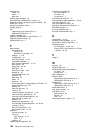scratch cartridge. A data cartridge that contains no
useful data, but can be written to with new data.
SCSI. See Small Computer Systems Interface.
SCSI bus. (1) A collection of wires through which data
is transmitted from one part of a computer to another.
(2) A generic term that refers to the complete set of
signals that define the activity of the Small Computer
Systems Interface (SCSI).
SCSI connector. Located at the rear of the Ultrium
Tape Drive, the connector that facilitates commands to
and from the server, and to which the internal SCSI
cable of an enclosure connects.
SCSI device. Anything that can connect into the SCSI
bus and actively participate in bus activity.
SCSI drive sense data. In response to inquiry from
the server about an error condition, a packet of SCSI
sense bytes that contains information about the error
and that is sent back to the server by the drive.
SCSI ID. The unique address (from 1 to 15) that you
assign to an Ultrium Tape Drive that uses a SCSI
interface (Model T200).
SCSI ID connector. Located at the rear of the Ultrium
Tape Drive, the connector that enables the drive’sSCSI
address to be set. Addresses are determined by the
placement of jumpers on the pins.
SCSI ID switch. Located on an enclosure that
contains a Ultrium Tape Drive, a mechanism that
connects to the drive and allows you to change the
drive’s SCSI ID without using jumpers.
SCSI log sense data. In response to inquiry from the
server about the Ultrium Tape Drive’s error logs and
counters, a packet of SCSI sense bytes which contains
that information and which is sent back to the server by
the drive. Log sense data is used to diagnose problems,
especially if the problems are intermittent.
SCSI wrap plug. A connector mechanism that
connects to a SCSI port for the purpose of testing the
Ultrium Tape Drive’s circuitry for the SCSI interface.
SCSI wrap test. A diagnostic that can be run on the
Ultrium Tape Drive to determine whether the circuitry
functions properly to and from the SCSI connector.
selection time-out. Following the selection of an
option (for example, a data transfer), the period of time
during which it is determined that there is a bad
connection between the server and the drive.
sense data. Data that describes an I/O error. Sense
data is presented to a server in response to a Sense
I/O command.
serial interface. An interface that sequentially or
consecutively executes two or more operations in a
single device, such as an arithmetic and logic operation.
server. A functional unit that provides services to one
or more clients over a network. Examples include a file
server, a print server, or a mail server. The IBM
Eserver pSeries, IBM Eserver iSeries, HP, and Sun
are servers. Synonymous with host.
ship group. The group of supplies, cords, or
documentation that is shipped with the Ultrium Tape
Drive.
shipping environment. The temperature, relative
humidity rate, and wet bulb temperature of the
environment to which the Ultrium Tape Drive is exposed
when it is transferred from one location to another.
short-wave cable. In Fibre Channel technology, a
laser cable that uses a wavelength of 780 nanometers
and is only compatible with multimode fiber.
single-character display. Located at the front of the
Ultrium Tape Drive, an LED that presents an
alphabetical or numeric code which represents a
diagnostic or maintenance function, error condition, or
informational message.
Small Computer Systems Interface (SCSI). A
standard used by computer manufacturers for attaching
peripheral devices (such as tape drives, hard disks,
CD-ROM players, printers, and scanners) to computers
(servers). Pronounced ″scuzzy.″ Variations of the SCSI
interface provide for faster data transmission rates than
standard serial and parallel ports (up to 160 megabytes
per second). The variations include:
v Fast/Wide SCSI: Uses a 16-bit bus, and supports
data rates of up to 20 MBps.
v SCSI-1: Uses an 8-bit bus, and supports data rates
of 4 MBps.
v SCSI-2: Same as SCSI-1, but uses a 50-pin
connector instead of a 25-pin connector, and
supports multiple devices.
v Ultra SCSI: Uses an 8- or 16-bit bus, and supports
data rates of 20 or 40 MBps.
v Ultra2 SCSI: Uses an 8- or 16-bit bus and supports
data rates of 40 or 80 MBps.
v Ultra3 SCSI: Uses a 16-bit bus and supports data
rates of 80 or 160 MBps.
soft addressing. Pertaining to the Fibre Channel drive
(Model T200F), a method that enables the drive to
dynamically arbitrate its AL_PA with other Fibre Channel
devices on the loop. The AL_PA enables the drive to
communicate with other devices.
software. Programs, procedures, rules, and any
associated documentation pertaining to the operation of
a computer system.
Glossary 99
|
|
|
|
|
|
|
|
|
|
|
|
|
|
|
|
|
|
|
|
|
|
|
|
|
|
|
|
|
|
|
|
|
|
|
|
|
|
|
|
|
|
|
|
|
|
|
|
|
|
|
|
|
|
|
|
|
|
|
|
|
|
|
|
|
|
|
|
|
|
|
|
|
|
|
|
|
|
|
|
|
|
|
|
|
|
|
|
|
|
|
|
|
|
|
|
|
|
|
|



